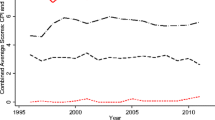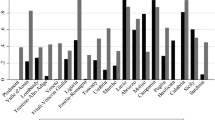Abstract
Using a sample of 56 countries (28 rich and 28 poor), observed over the period 2004–2013, our paper develops an analysis of the contagion of corruption at the inter-institutional level. More precisely, it examines whether corruption in the justice system is an important factor to explain the expansion of corruption in politics. We find a clear unidirectional causal effect of corruption in the justice system on corruption in parliament. Low corrupt justice induces low corrupt politics. The results are robust to various checks. It appears that reducing corruption in justice alone causes a direct reduction of corruption in politics. Since fighting corruption is very costly, the result highlights the additional benefit of devoting greater resources to curbing judicial corruption.


Similar content being viewed by others
Notes
Looking at the recent release of the three most commonly-used indicators of the prevalence of corruption, namely Transparency International’s Corruption Perceptions Index and the indicators provided by the International Country Risk Guide and the Worldwide Governance Indicators, no country, developed or developing, attains the best possible score.
The published results of the 2017 edition are not comparable to those of the previous editions. The 2017 results give the percentage of interviewees which have no opinion (coded 1), think that the given institution is not corrupt at all (coded 2), partially corrupt (3), corrupt (4) and, extremely corrupt (5). The sum of the five percentages is 100. In contrast, the results for 2003 to 2013 give the percentage of interviewees who think that the given institution is not corrupt at all (1), little corrupt (2), moderately corrupt (3), corrupt (4) and very highly corrupt (5). The sum of the five percentages is 100. No information is given about interviewees who have no opinion in the results of 2003 to 2013. Hence, it is not possible to combine the two sets of results.
https://www.transparency.org/en/gcb/global/global-corruption-barometer-2013/press-and-downloads
https://www.transparency.org/en/gcb/global/global-corruption-barometer-2017/press-and-downloads.
References
Adsera, A., Boix, C., & Payne, M. (2003). Are you being served? Political accountability and quality of government. Journal of Law, Economics and Organization, 19(2), 445–490.
Aidt, T. S. (2016). Rent seeking and the economics of corruption. Constitutional Political Economy, 27(2), 142–157.
Aidt, T. S. (2019). Corruption. In R. D. Congleton, B. Grofman, & S. Voigt (Eds.), The Oxford handbook of public choice. (Vol. 1). Oxford University Press.
Aidt, T. S., & Dutta, J. (2008). Policy compromises: Corruption and regulation in a democracy. Economics and Politics, 20(3), 335–360.
Andersen, T. B., Bentzen, J., Dalgaard, C. J., & Selaya, P. (2011). Does the internet reduce corruption? Evidence from US States and across countries. World Bank Economic Review, 25(3), 387–417.
Arellano, M., & Bond, S. (1991). Some tests of specification for panel data: Monte Carlo evidence and an application to employment equations. Review of Economic Studies, 58, 277–297.
Arezki, R., & Brückner, M. (2011). Oil rents, corruption and state stability: Evidence from panel data regressions. European Economic Review, 55(7), 955–963.
Attila, G., (2008). Is corruption contagious? An econometric analysis. Norwegian institute of international affairs. In: Department of International Economics. NUPI Working Paper 742.
Basu, K. (2011). Why, for a class of bribes, the act of giving a bribe should be treated as legal. Ministry of Finance Working Paper.
Beck, N., & Katz, J. N. (2011). Modeling dynamics in time-series–cross-section political economy data. Annual Review of Political Science, 14, 331–352.
Becker, S., Egger, P., & Seidel, T. (2009). Common political culture: Evidence on regional corruption contagion. European Journal of Political Economy, 25(3), 300–310.
Billger, S. M., & Goel, R. K. (2009). Do existing corruption levels matter in controlling corruption?: Cross-country quantile regression estimates. Journal of Development Economics, 90(2), 299–305.
Blundell, R., & Bond, S. (1998). Initial conditions and moment restrictions in dynamic panel data models. Journal of Econometrics, 87, 11–143.
Botero, J. C. and Ponce, A. (2010). Rule of law index. The World Justice Project.
Brunetti, A., & Weder, B. (2003). A free press is bad news for corruption. Journal of Public Economics, 87(7), 1801–1824.
Correa, E. A., Jetter, M., & Agudelo, A. M. (2016). Corruption: Transcending borders. Kyklos, 69(2), 183–207.
Di Tella, R., & Franceschelli, I. (2011). Government advertising and media coverage of corruption scandals. American Economic Journal: Applied Economics, 3(4), 119–151.
Dilyan, D., & Ujhelyi, G. (2014). What do corruption indices measure? Economics and Politics, 26(2), 309–331.
Djankov, S., Mcliesh, C., Nenova, T., & Shleifer, A. (2003). Who Owns the Media? The Journal of Law and Economics, 46(2), 341–382.
Dong, B., Dulleck, U., & Torgler, B. (2012). Conditional corruption. Journal of Economic Psychology, 33(3), 609–627.
Duncan, G. (2014). Drug trafficking and political power: oligopolies of coercion in Colombia and Mexico. Latin American Perspectives, 41(2), 18–42.
Elbahnasawy, N. G. (2014). E-government, internet adoption, and corruption: An empirical investigation. World Development, 57, 114–126.
Fisman, R., & Gatti, R. (2002a). Decentralization and corruption: Evidence across countries. Journal of Public Economics, 83(3), 325–345.
Fisman, R., & Gatti, R. (2002b). Decentralization and corruption: Evidence from US federal transfer programs. Public Choice, 113(1–2), 25–35.
Galbraith, J. K. (1997). The Great Crash 1929. Mariner Books.
Gerring, J., & Thacker, S. C. (2004). Political institutions and corruption: The role of Unitarism and Parliamentarism. British Journal of Political Science, 34(02), 295–330.
Glaeser, E., & Saks, R. (2006). Corruption in America. Journal of Public Economics, 90, 1053–1072.
Gokcekus, O., & Suzuki, Y. (2011). Business cycle and corruption. Economics Letters, 111, 138–140.
Gutmann, J., & Voigt, S. (2019). The independence of prosecutors and government accountability. Supreme Court Economic Review, 27(1), 1–19.
Herzfeld, T., & Weiss, C. (2007). Corruption clubs: Empirical evidence from kernel density estimates. Applied Economics, 39(12), 1565–1572.
Jain, A. K. (2001). Corruption: A review. Journal of Economic Surveys, 15(1), 71–121.
Johnsøn, J., and Hardoon, D. (2012). Why, when and how to use the Global Corruption Barometer. U4 Brief.
Judson, R. A., & Owen, A. L. (1999). Estimating dynamic panel data models: A guide for macroeconomists. Economics Letters, 65(1), 9–15.
Kiviet, J. F. (1995). On Bias, inconsistency, and efficiency of various estimators in dynamic panel models. Journal of Econometrics, 68, 53–78.
Knack, S., & Azfar, O. (2003). Trade intensity, country size and corruption. Economics of Governance, 4(1), 1–18.
La Porta, R., Lopez-de-Silanes, F., & Shleifer, A. (2008). The economic consequences of legal origins. Journal of Economic Literature, 46, 285–332.
Lambsdorff, J. G. (1999). The transparency international corruption perceptions index 1999: Framework document. Transparency International.
Li, H., Xu, L. C., & Zou, H. F. (2000). Corruption, income distribution and growth. Economics and Politics, 12(2), 155–182.
Lio, M. C., Liu, M. C., & Ou, Y. P. (2011). Can the internet reduce corruption? A Cross-country study based on dynamic panel data models. Government Information Quarterly, 28(1), 47–53.
Lippitt, A. H. (2013). An empirical analysis of the foreign corrupt practices act. Virginia Law Review, 98, 1893–1930.
Lui, F. T. (1986). A dynamic model of corruption deterrence. Journal of Public Economics, 31(2), 215–236.
Mauro, P. (1995). Corruption and growth. The Quarterly Journal of Economics, 110(3), 681–712.
McMillan, J., & Zoido, P. (2004). How to subvert democracy: Montesinos in Peru. Journal of Economic Perspectives, 18(4), 69–92.
Meier, K. J., & Holbrook, T. M. (1992). I seen my opportunities and I took’em: Political corruption in the american states. The Journal of Politics, 54(1), 135–155.
Michnik, A., & Matynia, E. (2001). The Montesinos virus. Social Research 905–916.
Mishra, A. (2006). Persistence of corruption: Some theoretical perspectives. World Development., 34(2), 349–358.
Olken, B. A. (2009). Corruption perceptions vs. corruption reality. Journal of Public Economics, 93(7), 950–964.
Petrova, M. (2011). Newspapers and parties: How advertising revenues created an independent press. American Political Science Review, 105(04), 790–808.
Reinikka, R., & Svensson, J. (2005). Fighting corruption to improve schooling: Evidence from a newspaper campaign in Uganda. Journal of the European Economic Association, 3(2–3), 259–267.
Rock, M. T. (2009). Corruption and democracy. Journal of Development Studies, 45(1), 55–75.
Rose-Ackerman, S. (1996). When is corruption harmful? World Bank.
Sargan, J. D. (1958). The estimation of economic relationships with instrumental variables. Econometrica, 26(3), 393–415.
Sekkat, Kh. (2018). Is corruption curable? Palgrave Macmillan.
Shleifer, A., & Vishny, R. W. (1993). Corruption. Quarterly Journal of Economics, 108(3), 599–617.
Staiger, D., & Stock, J. H. (1997). Instrumental variables regression with weak instruments. Econometrica, 65(3), 557–586.
Strömberg, D. (2004). Radio’s impact on public spending. Quarterly Journal of Economics, 119(1), 189–221.
Tavits, M. (2010). Why do people engage in corruption? The Case of Estonia. Social Forces, 88(3), 1257–1279.
TI (Transparency International). (2007). Global Corruption Report 2007. Cambridge University Press.
Treisman, D. (2000). The causes of corruption: A cross-national study. Journal of Public Economics, 76(3), 399–457.
Vadlamannati, K. C. (2015). Fighting corruption or elections? The politics of anti-corruption policies in India: A subnational study. Journal of Comparative Economics, 43(4), 1035–1052.
van Aaken, A., Feld, L. P., & Voigt, S. (2010). Do independent prosecutors deter political corruption? An empirical evaluation across seventy-eight countries. American Law and Economics Review, 12(1), 204–244.
Voigt, S., & Gutmann, J. (2015). On the wrong side of the law–Causes and consequences of a corrupt judiciary. International Review of Law and Economics, 43(1), 156–166.
Voors, M. J., Bulte, E. H., & Et Damania, R. (2011). Income shocks and corruption in Africa: Does a virtuous cycle exist? Journal of African Economies, 20(3), 395–418.
Author information
Authors and Affiliations
Corresponding author
Additional information
Publisher's Note
Springer Nature remains neutral with regard to jurisdictional claims in published maps and institutional affiliations.
Rights and permissions
About this article
Cite this article
Sekkat, K. Have you been served, your honor? Yes, thank you, your excellency: the judiciary and political corruption. Const Polit Econ 33, 326–353 (2022). https://doi.org/10.1007/s10602-021-09348-4
Accepted:
Published:
Issue Date:
DOI: https://doi.org/10.1007/s10602-021-09348-4




